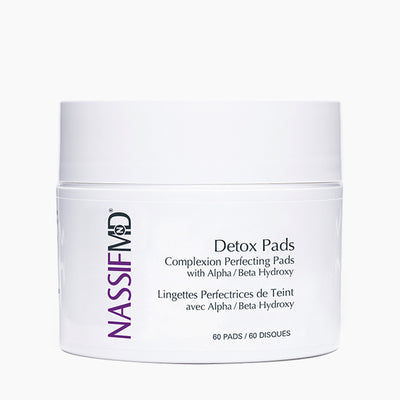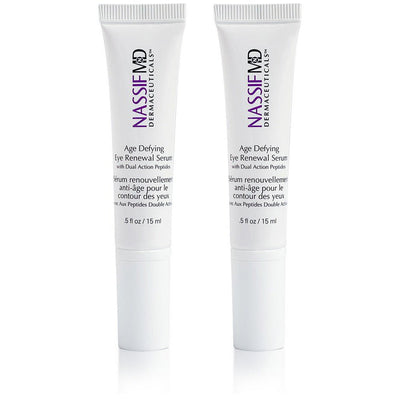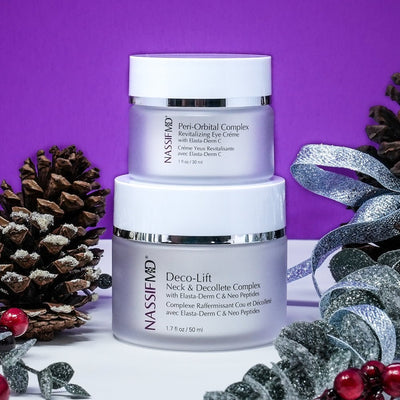How to Transition Your Skincare Routine from Winter to Spring
Just as you transition your wardrobe with changes in the seasons, your skincare needs to transition from winter to spring.
As spring approaches and moves into summer, you’ll spend less time in dry, heated indoor air and more time outside. Your skin will be in contact with more humidity, UV rays, pollution, and other factors requiring a different approach to your skincare routine.
Spring skincare aims to feel lighter, refreshing, and offer more protection. This article will walk you through just how to do that. We’ll cover the main tips from Dr. Nassif, a leading plastic and reconstructive surgeon with an extensive understanding of maintaining skin health through exfoliation, nourishment, hydration, and protection.
Keep reading to learn more about:
- How to promote spring skin hydration
- How to protect your skin with antioxidants and daily SPF
- How to gently exfoliate and promote new skin cells
Let’s get started!
Make the Transition from Winter to Spring with These Tips
As the weather shifts from winter to spring, you may notice that your skincare products feel heavy or your skin is more oily. These are signs that it’s time to transition your skincare routine to align with the natural changes in the seasons.
Here are Dr. Nassif’s top tips for making the transition with ease, including what ingredients to look for in skincare products for spring.
Switch from Heavy Creams to a Lightweight Moisturizer
In many places, spring air is more humid than dry winter air. Skin hydration is a primary focus of winter skincare routines. Thick, heavy moisturizing creams and lotions make sense in the winter.
In the spring, hydration is still important; it just may not take the driver’s seat in your routine. Switching from a heavy product to a lightweight moisturizer will prevent oily skin and help you feel more comfortable and confident in your skin.
Prevent Oily Skin with Light Hydration
Lighter layers work well in a summer skincare routine. You can get the moisture you need from a serum such as a water-based, gel serum or a light moisturizer. Note that serums help pull moisture into the skin, while moisturizing products seal it. For many, a serum is enough in the warmer months.
Hyaluronic acid is the number one skincare ingredient for spring skin hydration. Hyaluronic acid is a natural component of healthy skin. As a topical product, it easily penetrates the skin layers and pulls water in. It’s also anti-inflammatory and promotes skin healing and regeneration.
Incorporate Antioxidants
Skin protection becomes critical as the seasons shift and you are outside for more sunny days. Antioxidants are your first line of defense against UV radiation, air pollution, and other toxins that contact the skin.
What are antioxidants? Antioxidants are important nutrients in every cell that neutralize damaging free radical molecules. Antioxidants are an umbrella category for all the molecules with this action, including certain vitamins, minerals, and phytonutrients (plant compounds).
The skin has an affinity for antioxidants that are stored in skin cells and offset the damaging conditions the skin faces every day. In the spring, it’s vital to build up antioxidant protection.
Fight Free Radical Damage and Improve Skin Tone
The benefits of antioxidants for the skin go beyond fighting free radical damage; they improve skin tone, increase collagen production, and much more. Here are three of Dr. Nassif’s most-recommended vitamin antioxidants for topical use in skincare.
- Retinol – Retinol is a biologically active form of vitamin A that provides antioxidant protection in the skin. It has many other benefits, including:
- Supporting a healthy epidermis by regulating cell turnover
- Allows hyaluronic acid to accumulate in the skin, promoting hydration
- Prevents collagen loss with age, improving skin structure
Because of these actions, retinol is a well-known skincare ingredient for treating acne, improving the appearance of fine lines and wrinkles, and healing from sun damage.
Bakuchiol is a plant-derived extract with retinol-like properties, known for protecting the skin from free radicals, inflammation, and aging.
- Vitamin C – Vitamin C is a well-known antioxidant, working both internally and externally to protect the skin from UV radiation and other sources of free radicals. It’s also a required cofactor for collagen production.
Good vitamin C levels in the skin improve skin tone, skin barrier function, collagen levels, skin healing, and more. It’s also well-tolerated and a great addition to your skincare routine.
- Niacinamide – Niacinamide is an active form of vitamin B3, niacin, critical for cellular metabolism and its antioxidant functions. As an ingredient in skincare products, niacinamide helps stabilize the skin barrier, hydrate, and protect the skin. The result is a reduction of fine lines and a more even skin tone.
Protect Skin Against Sun Exposure
Antioxidant levels in the skin protect against toxin exposure, dull skin, aging, and more. They are indispensable. However, as you spend more time outdoors in the spring and summer, sun exposure increases, and you need additional UV protection.
Protecting your skin from the sun is essential for maintaining younger-looking skin. Interestingly, up to 80% of aging seen on the face is due to UV exposure from the sun, which damages DNA and skin cells, leading to age spots, wrinkles, and cancer.
Why Daily SPF is Key
If you do only one thing differently with your spring skincare, commit to daily SPF. SPF (or sun protection factor) are skincare ingredients like zinc oxide that absorb or reflect the sun’s rays so they can’t damage the skin. It’s one of the most proven and effective ways to preserve the skin’s health on your face, neck, hands, and other body parts most exposed to sunlight.
Exfoliate Dry Winter Skin Away
Over the winter, dead skin cells accumulate on the skin’s surface, making it appear dull and dry, with fine lines and other signs of aging. Exfoliation removes dead skin and increases cellular turnover, allowing nutrients, antioxidants, and hydration in your skincare to penetrate the skin and work more effectively.
Gentle exfoliation can be accomplished physically by cleansing with an abrasive surface or chemically with hydroxy acids. Naturally occurring hydroxy acids include salicylic, glycolic, and lactic acids. (Read more about each hydroxy acid here.)
Benefits of Daily Exfoliation
Exfoliation doesn’t need to wait until spring; it can be part of your daily skincare routine.
Benefits of daily exfoliation include:
- More even skin tone and texture
- Improved appearance of fine lines and wrinkles
- Reduced redness and inflammation
- Reduced acne breakouts
Your Spring Skincare Routine
NassifMD® products are scientifically formulated with ingredient synergy in mind. While any one of these skincare ingredients has benefits, the benefits are more significant when combined.
When it comes to spring skincare, here are some light, nourishing products to consider for hydration, exfoliation, and protection.
- NassifMD® Protect & Hydrate add link to original product if preferred
How to use: Apply as the last step of your morning skincare routine before makeup. Reapply before sun exposure or as needed with repeated exposure.
- NassifMD® Daily Revitalizing Antioxidant Serum is an oil-free, lightweight, revitalizing serum that is a must-have in your spring skincare routine. Its concentrated antioxidants from vitamin C, niacinamide, and plant extracts provide powerful free radical protection during the day.
How to use: Apply in the morning after cleansing and NassifMD® Detox Pads. Lock it in with NassifMD® Hydro-Gel and follow with sunscreen.
- NassifMD® Detox Pads offer gentle exfoliation for skin detoxification and cell turnover from alpha hydroxy acids. Each pad contains a synergy of ingredients, including vitamin C (as Elasta-derm C) and bakuchiol extract for antioxidant protection. Read more about why detox pads should be a staple here.
How to use: Use twice daily after cleansing for gentle exfoliation. Follow with the rest of your skincare routine. If you are in a pinch or travelling, NassifMD® Detox Pads can be used in place of a cleanser – they are that good!
- NassifMD® Hydro-Gel with Hyaluronic Acid & Retinol is an oil-free, rosemary water-based gel synergistically designed to exfoliate, hydrate, and nourish the skin. It contains Hy-Retin, a hyaluronic acid + retinol molecule to reduce the signs of aging, brighten skin tone, and even texture.
How to use: NassifMD® Hydro-Gel can be used morning and night and easily layers with other skincare products. In the morning, use it as a primer before applying makeup. At night, apply as the last step before a moisturizer (if using).
Use the sign of longer days and warmer weather to adjust your skincare routine for spring. Move away from heavy products toward lighter, protective options that layer well and support skin health with synergistic ingredients, including hydroxy acids, antioxidants, and hyaluronic acid. Some minor tweaks in your routine can make all the difference in your skin health!
References
- Juncan, A. M., Moisă, D. G., Santini, A., Morgovan, C., Rus, L. L., Vonica-Țincu, A. L., & Loghin, F. (2021). Advantages of Hyaluronic Acid and Its Combination with Other Bioactive Ingredients in Cosmeceuticals.Molecules (Basel, Switzerland), 26(15), 4429.
- Baek, J., & Lee, M. G. (2016). Oxidative stress and antioxidant strategies in dermatology.Redox report : communications in free radical research, 21(4), 164–169.
- Puścion-Jakubik, A., Markiewicz-Żukowska, R., Naliwajko, S. K., Gromkowska-Kępka, K. J., Moskwa, J., Grabia, M., Mielech, A., Bielecka, J., Karpińska, E., Mielcarek, K., Nowakowski, P., & Socha, K. (2021). Intake of Antioxidant Vitamins and Minerals in Relation to Body Composition, Skin Hydration and Lubrication in Young Women.Antioxidants (Basel, Switzerland), 10(7), 1110.
- Riahi, R. R., Bush, A. E., & Cohen, P. R. (2016). Topical Retinoids: Therapeutic Mechanisms in the Treatment of Photodamaged Skin.American journal of clinical dermatology, 17(3), 265–276.
- Bluemke, A., Ring, A. P., Immeyer, J., Hoff, A., Eisenberg, T., Gerwat, W., Meyer, F., Breitkreutz, S., Klinger, L. M., Brandner, J. M., Sandig, G., Seifert, M., Segger, D., Rippke, F., & Schweiger, D. (2022). Multidirectional activity of bakuchiol against cellular mechanisms of facial ageing - Experimental evidence for a holistic treatment approach.International journal of cosmetic science, 44(3), 377–393.
- Pullar, J. M., Carr, A. C., & Vissers, M. C. M. (2017). The Roles of Vitamin C in Skin Health.Nutrients, 9(8), 866.
- Gehring W. (2004). Nicotinic acid/niacinamide and the skin.Journal of cosmetic dermatology, 3(2), 88–93.
- Guan, L. L., Lim, H. W., & Mohammad, T. F. (2021). Sunscreens and Photoaging: A Review of Current Literature.American journal of clinical dermatology, 22(6), 819–828.
- Liu, H., Yu, H., Xia, J., Liu, L., Liu, G. J., Sang, H., & Peinemann, F. (2020). Topical azelaic acid, salicylic acid, nicotinamide, sulphur, zinc and fruit acid (alpha-hydroxy acid) for acne.The Cochrane database of systematic reviews, 5(5), CD011368.
- Bhardwaj, V., Sharma, K., Maksimovic, S., Fan, A., Adams-Woodford, A., & Mao, J. (2021). Professional-Grade TCA-Lactic Acid Chemical Peel: Elucidating Mode of Action to Treat Photoaging and Hyperpigmentation.Frontiers in medicine, 8, 617068.



































